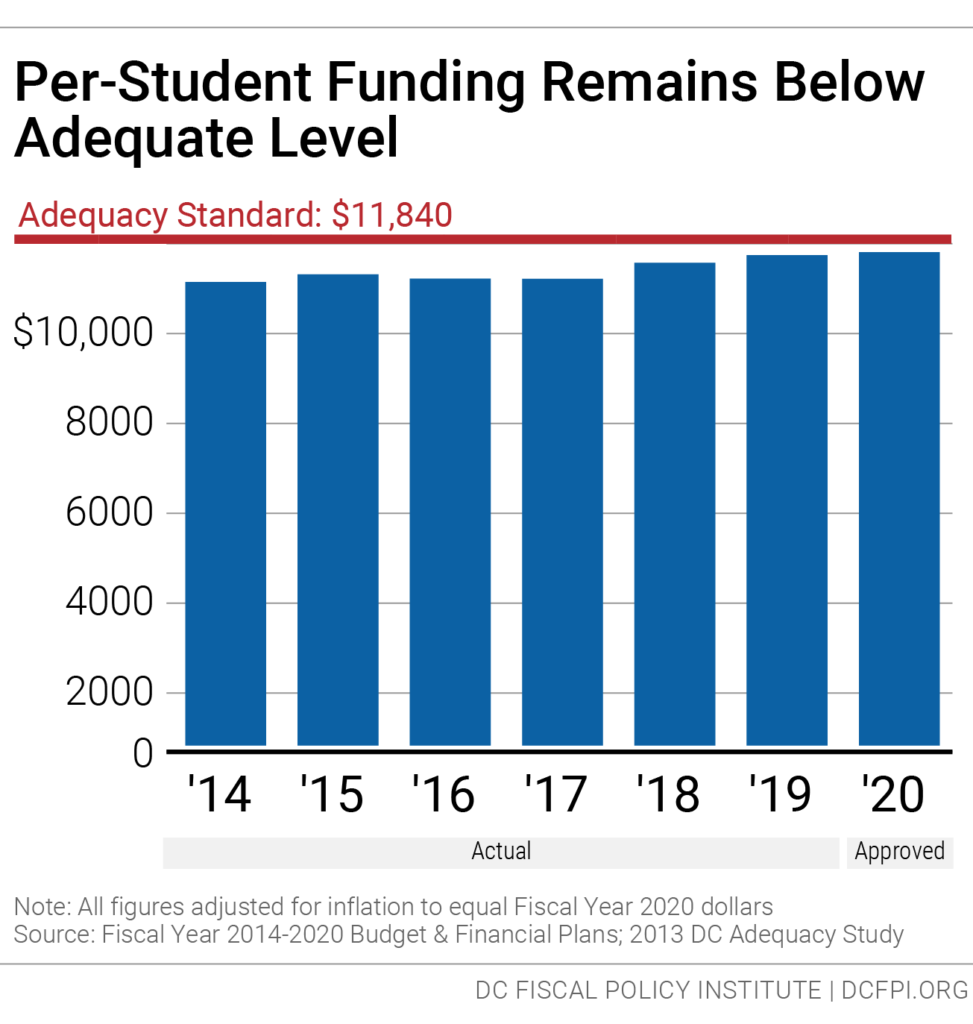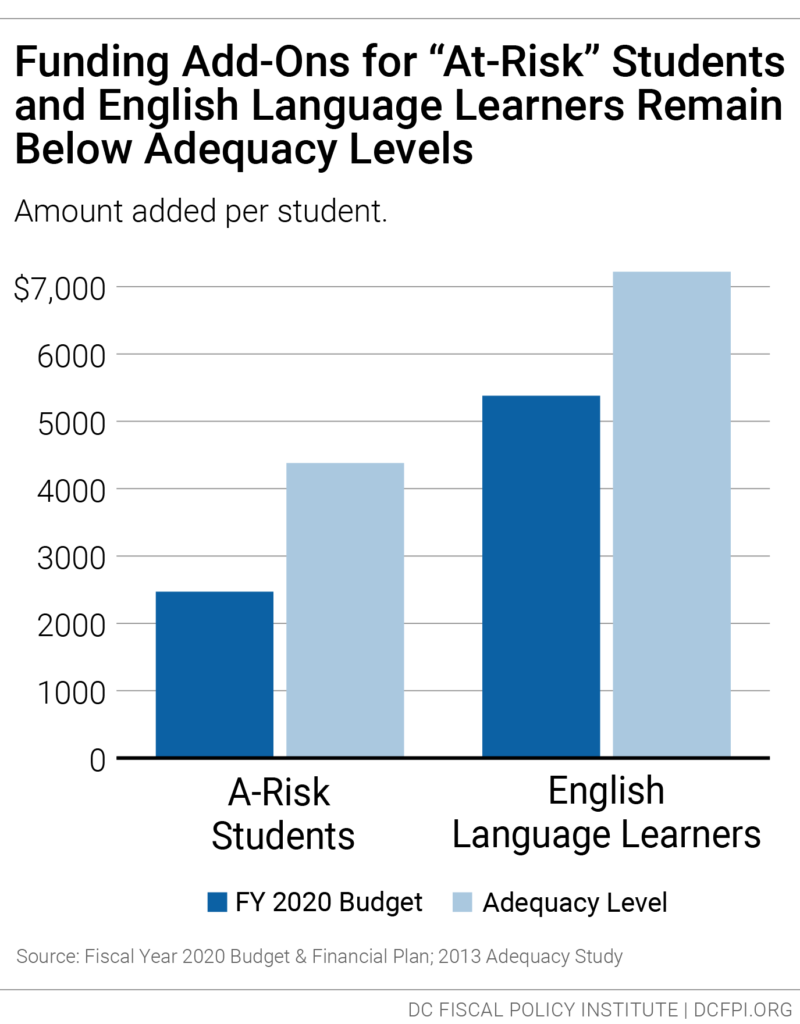The Fiscal Year (FY) 2020 DC education budget should provide traditional public schools and public charter schools with the resources they need to enable all students to meet academic performance standards and thrive. Yet, policymakers have consistently underfunded the education budget below the recommended levels in the DC Education Adequacy Study and failed to increase funding in pace with rising personnel and staffing model costs (Figure 1)

- District of Columbia Public Schools (DCPS) faced a $25 million deficit in FY 2020.
- DCPS cannot fully fund its staffing model without supplanting funds intended for students who are considered “at-risk” of academic failure.
- Many DCPS schools in Wards 7 and 8 saw a budget cut of five percent or more in the 2019-20 school year, a violation of D.C. Code.
- Some public charter school teachers are not paid a living wage.
Fully Fund DCPS and Public Charter Schools
Increase the Funding Formula by 6 Percent to Close the Adequacy Gap in Two Years
In 2013, the Deputy Mayor for Education (DME) released a study of the costs of providing an educational program to support all students in meeting academic standards. The DC Education Adequacy study recommended a base per-student funding level of $10,557, or $11,839 in 2020 dollars. The current Uniform-Per-Student-Funding-Formula (UPSFF) base allotment is currently seven percent below this recommended level. The Mayor and DC Council should prioritize reaching an adequate school budget as quickly as possible, over the next two years, by raising the base of the UPSFF by 6 percent in FY 2021, which includes a 3.5 percent increase in the base plus a projected inflation rate of 2.5 percent.
Use Standard Measures to Increase the Funding Formula
Currently, DC has no standard to ensure that school funding rises each year to address growing costs such as teacher pay and maintenance. Funding increases in DC’s school funding formula have been arbitrary in recent years, and for much of the past decade total school funding per-pupil failed to keep up with inflation. For FY 2021 and beyond, lawmakers should adjust the District’s per-student funding formula using a standard measure of inflation that is targeted to education costs in DC.
Provide Stabilization Funds to Declining Enrollment Schools
Under DCPS school allocation rules, schools receive “stabilization funds” to ensure that their funding doesn’t drop substantially from year to year. In recognition of DCPS’s unique obligation to operate by-right schools in all neighborhoods, DCPS should have access to stabilization funds outside of the UPSFF.
Increase and Protect At-Risk and English Learner Funds
DC’s funding formula provides additional money to schools to support students who are low-income, experiencing homelessness, in foster care, or overage and under-credited in high school. “At-risk” funds are a powerful tool to increase the equity of school funding and address distressing differences between the educational outcomes for white students and students of color, whom are more likely to be identified as “at-risk.” In 2019, 83% of white students were college- and career-ready compared to only 25 percent of Black students, and 34% of Latinx students. These inequities reflect historic and ongoing barriers to quality education and good jobs, housing discrimination, and segregation.

The current school funding formula provides an additional $2,470 for every “at-risk” student—44 percent below the recommended level. Equally important, DCPS has misspent about half of “at-risk” funds in recent years, using the funds for regular staff positions and school expenses across all schools rather than directing funds to schools in proportion to the number of at-risk student attending each school, as the law requires. The funding formula provides an added $5,380 for each English Learner, or 26 percent below the recommended level.
The FY 2021 DC budget should increase the at-risk and English Learners weights and put them on a path to reaching the full adequacy level. Policymakers should hold DCPS accountable to devoting 100 percent of at-risk funds to the intended students and schools.
Grow School-Based Behavioral Health Services in Public Schools
In order to create an education system that supports the mental health needs of DC students, the District should make the following investments:
- Ensure schools have access to mental health professionals – especially those that support students with the greatest needs. An investment of at least $16 million will allow DC to expand the Department of Behavioral Health’s School Behavioral Health Program from 119 to 179 schools.
- Ensure all schools provide high-quality, culturally affirming and responsive evidence-based social emotional learning programs as well as trauma-informed training and restorative practices for all staff. This will take an investment of $10.6 million for all 236 schools.
Keep the Lights on After School: Increase Investments in Out-of-School Time Programs
Out-of-School Time (OST) programs—after school and summer—have been shown to increase student engagement, foster positive social-emotional development, and boost self-esteem—factors that help students succeed in and out of the classroom. In recent years, the District has made historic investments in OST programs, however further increases are needed to enable low-income and other students who need it most to have access to the same enriching OST opportunities as their more well-off peers.
The FY 2021 DC budget should invest $25 million in OST programming. This includes $19 million for Learn 24’s Office of Youth Grants and Opportunities—a $5.1 million increase over the current funding level—and $5.9 million for programs funded through the Department of Parks and Recreation.
